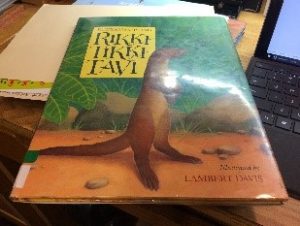Rikki-Tikki-Tavi

- Rikki-Tikki-Tavi
- Author: Rudyard Kipling
- Illustrator: Lambert Davis
- Publisher and Year: Harcourt Brace and Company, 1992
- Number of pages: 37
- Genre: Picture Book/Adventure Story
- Analysis: In Rudyard Kipling’s book, Rikki-Tikki-Tavi, a young Indian mongoose named Rikki-Tikki-Tavi is found by a British family in Colonial India and helps save them from the two vicious cobras, Nag and Nagaina, that are native to that part of India. The mongoose never runs out of stamina and fighting spirit as they take on a determined and ferocious enemy to protect their adopted family, but eventually, after keeping it up for a good while and outwitting their cunning at every turn, the enemy is defeated, proving that you can accomplish most anything if the conditions are right and you don’t give up on your goal.The most important element of the picturebook codes that I saw in this book was that of size. Towards the end, when Rikki-Tikki-Tavi meets and attacks Nag to destroy him once and for all, he is much smaller than the giant, nasty cobra, who he attacks by biting on the head with extreme prejudice, showing that Nag is the one in control of the situation when he is attacked by Rikki-Tikki-Tavi. When shown next to the humans (even counting the baby), Nag is much, much smaller as he is fatally shot by the father in the colonial family after Rikki-Tikki-Tavi points out the location to him. The snake itself is always bigger when it is by humans, showing its puny size in comparison to Rikki-Tikki-Tavi. The illustrations are quite beautiful, as they are both colorful yet simple. The illustrator chose a lovely strategy of using many shades of watercolors for the animals, and it is even more poignant when contrasted with the crisp khaki uniforms of the British officer and his family. Finally, when it comes to special features, the two that come to mind is the fact that there is a very summary of Kipling’s life immediately following the book jacket, and the pages themselves are pretty text-averse too. Additionally, the fact that this is adapted from a mere short story into a children’s book is quite fascinating, as Lambert Davis could make it palatable to a younger audience with his deluxe illustrations. The ideology of the book is that it wants everybody to do selfless things for those who do good by them, and in doing so will be able to “fight the cobra” that they were struggling with inside of them all along. However, there is another implication here that is glossed over-the idea that colonialism is a beneficial system of governance, and that the British colonial families are the most critical elements in the British Raj, much more so than the native Indians. In fact, they are not even shown in the illustrations whatsoever, perhaps an oversight by the author in 1992 and/or an embrace of Kipling’s nonchalance towards those who did the heavy lifting in that British colony.

